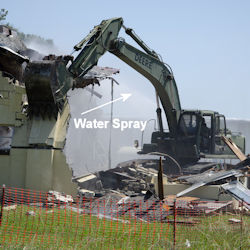Dust Hazard Controls in Demolition
Dust hazards during building demolition are a significant concern, both for worker safety and environmental impact. OSHA provides guidelines and strategies to manage and minimize these hazards.
As previously mentioned, dust generated during demolition can contain a variety of harmful materials, including silica, asbestos, lead, and other toxic substances.
- Risk Assessment: Before demolition, conduct a thorough assessment to identify materials that could create hazardous dust. This may involve testing materials for asbestos, lead, or other harmful substances.
- Water Sprays/Misting: Applying water to the demolition site significantly reduces the amount of dust that becomes airborne. Water droplets bind with dust particles, increasing their weight and causing them to settle rather than dispersing into the air. This method is most effective for controlling silica dust, which is one of the most hazardous types of dust generated during demolition.
- Local Exhaust Ventilation (LEV): While water misting is highly effective, it can be complemented with LEV systems, which capture dust at or near its source and remove it from the work area. This is particularly important in enclosed or partially enclosed spaces where water sprays might not be as effective.
- Regular Cleaning and Debris Removal: Regularly cleaning the site and promptly removing debris can reduce the amount of dust that can become airborne.
- Enclosure and Segregation: Enclosing the demolition area and using barriers or negative pressure enclosures helps contain dust within a controlled area. This is effective in preventing the spread of dust to surrounding areas.
- Personal Protective Equipment (PPE): Provide workers with appropriate PPE, including respirators with the correct filters for the type of dust present, protective clothing, and goggles.
- Air Monitoring: Regularly monitor air quality in and around the demolition site to ensure dust levels are controlled and within safe limits.
- Decontamination Facilities: Provide facilities for workers to remove and clean clothing and equipment that may be contaminated with hazardous dust.
- Safe Work Practices: Using demolition methods that produce less dust, such as using precision cutting techniques instead of more aggressive methods, can also help control dust generation.
- Post-Demolition Clean-Up: Ensure thorough clean-up procedures are in place to prevent dust from remaining on-site, which could pose long-term health risks.
It's important to comply with all relevant OSHA standards, including those for silica (29 CFR 1926.1153), asbestos (29 CFR 1926.1101), and lead (29 CFR 1926.62).Adhering to these strategies not only helps in complying with OSHA regulations but also significantly reduces the health risks associated with dust exposure during building demolition. It's crucial for employers to implement and enforce these safety measures to protect workers and the surrounding environment.
Knowledge Check Choose the best answer for the question.
6-6. What is the most effective way to control dust hazards during building demolition?
You forgot to answer the question!

